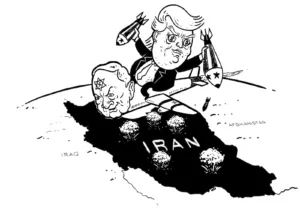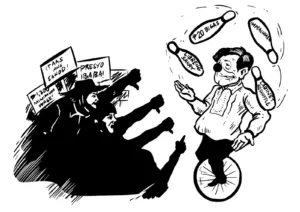By CPP International Department
Contribution to the International Communist Seminar
Belgium, 27-29 June 2014
We wish to discuss with you today three main points: (a) the specific characteristics of imperialism and war in the Philippines; (b) the Philippine revolutionary movement against imperialism, its local puppets, and modern revisionism; and (c) the internationalist tasks of the Communist Party of the Philippines in the global anti-imperialist movement for socialist revolution.
Monopoly capitalism, or modern imperialism, is parasitic, decaying and moribund. It is intrinsically violent and aggressive in the repression of revolution in its home ground, and in the acquisition of economic and political territories abroad. The completion of the division of the world among the most advanced capitalist powers at the turn of the 20th century ushered in the current era of imperialist wars and surrogate wars for the purpose of redividing the world among these imperialist powers.
Imperialism and war in the Philippines
As a rising industrial capitalist power, the United States of America instigated the Spanish-American War of 1898. Its industrial monopolies and finance oligarchs that dominated the economy sought new territories to sell their goods and invest surplus capital. They coveted the colonies of a decrepit colonial power Spain, and wrested control of its rebellious colonies of Cuba, Puerto Rico and the Philippine Islands.
Within the Philippine Islands, the various peoples of the 7,000 islands had united and began to wage armed revolution against Spanish colonialism in 1896. They formed a national army and government, and before the end of 1898, the revolutionary forces laid siege on the last bastion of Spanish rule in the archipelago – the walled city of Intramuros in Manila. But the US military forces systematically displaced the Filipino troops from their vantage point as more US reinforcements arrived.
The US imperialists pretended to be allies of the Filipino revolutionaries against Spain. But betraying their supposed allies, they arranged with Spain a mock battle in Manila in August 1898, at which Spain surrendered to the US.. The US and Spain then forged the Treaty of Paris in December 1898, whereby Spain ceded the Philippine Islands to the US in exchange for US$ 20 million. In February 1899, the US Expeditionary Forces in the Philippines waged a brutal war of conquest against the Filipino people. In the course of imposing its colonial rule from 1899 up to 1916, US military forces engaged in wholesale massacres, scorched earth tactics, food and economic blockades, population reconcentration, and other such barbarities, resulting in the death of 1.5 million Filipinos. The brutalities subsided only upon the defeat of the organized armed resistance of the people.
The US superimposed the monopoly capitalist mode of exploitation on the local feudal economy and fundamentally transformed it into a semi-feudal economy. US corporations profited tremendously from direct and indirect capital investments, as well as from the colonial exchange of US commodities for Philippine raw materials.
In order to quell the people’s demands to end feudal relations, the US colonial government expropriated some of the Spanish religious estates and redistributed these to landless peasants. The colonizers also allowed peasants to open land in frontier areas, and to seek jobs in the mines, public works, and in the urban areas. As a result, the number of industrial and service workers increased, and there was a decrease in the number of peasants paying land rent.
But US imperialism did not completely abolish feudalism. The peasants who received agricultural lands could not afford to pay them, and the land eventually fell into the hands of the local landlord class. At the same time, land cleared out by peasants in the frontier areas were eventually claimed and registered by the local bureaucrats and landlords.
The joint class rule of the big compradors bourgeoisie and landlords arose in the semi-feudal economy and society, replacing the monopoly rule of the landlord class during the feudal period of Spanish colonialism. The intermediate social classes of the middle and petty bourgeoisie expanded and would eventually become, respectively, one and eight per cent of the population. The working class grew to its present size of 15% of the population, while the peasantry decreased from a feudal high of 90% to its current semi-feudal level of 75%.
The US also superimposed its bourgeois and colonial culture on the feudal culture of the dominant Roman Catholic Church. It sought to make Filipinos forget about the brutality of the US war of aggression, and it continues to this day in misrepresenting itself as the Filipinos’ protector and the global model of democracy. It expanded and controlled the public school system, mass media, and other cultural venues for the propagation of reactionary ideas, bourgeois decadence, pacifism, and pro-imperialist liberalism. Alongside these, the US encouraged the spread of religious conservatism through religious schools and other cultural venues. Then and now, the US and its local puppets suppress expressions of patriotism and anti-imperialism among the population.
Anti-imperialist resistance for national and social liberation
Notwithstanding the extreme brutality and deviousness of the US imperialists, patriotism and the revolutionary aspirations of Filipinos for national liberation and democracy was never completely extinguished. In various open and clandestine ways, the people resisted US imperialist rule and its local puppets. The influences of the Great October Revolution and the revolutionary movements in the US itself, in Europe, and in China, reached Philippine shores. The Great Depression fuelled the emergence of fascist as well as anti-fascist movements around the world, re-igniting the mass movement of workers and the intelligentsia in the Philippines. These developments would culminate in the establishment of the Communist Party of the Philippine Islands in 1930.
Japanese imperialism invaded and occupied the Philippines from 1941 to 1945. It drove away US colonial forces and supplanted them with a nominally-independent but nonetheless puppet Philippine Republic. In the course of World War II, the merger party of the CPPI and Socialist Party was able to build the People’s Army Against Japan (Hukbalahap). Despite the right opportunist error of the “retreat for defense” policy and of fighting solely against Japanese imperialism but welcoming the return of US colonial rule – the Hukbalahap successfully attacked the Japanese armed forces, established a number of local organs of political power, and led mass movements to confiscate and redistribute landlord estates in several provinces.
The US defeated Japan in the Pacific War and reclaimed its Philippine colony in 1945. In 1946, it granted so-called independence to a group of Filipino bureaucrats representing the local exploiting classes of big compradors and landlords, that ensured US imperialist interests would continue to be served.
The local ruling classes, with the full backing of the US, employed brutal military campaigns against the communist leaders, the People’s Army and the people. They nullified the land reform and other social gains made during the war of liberation against the Japanese invasionary forces. They broke the backbone of the armed revolutionary movement in the early 1950s, mainly as a result of the opportunist errors of the Party and army leadership. The Party expressed support for the return of US imperialist rule and considered parliamentary struggle as the primary form of struggle. Frustrated by fraud and terrorism in the parliamentary arena, it then swung to a putschist policy of quick military victory against the much-superior counter-revolutionary armed forces.
It was a matter of life or death for the revolutionary movement that necessitated the re-establishment of the Communist Party of the Philippines in 1968, as the advanced detachment of the working class, under the guidance of Marxism-Leninism-Maoism. It rectified the grave errors of the previous revolutionary movement led by the CPPI and the merger CPPI-SP. It put forward the general line of people’s democratic revolution with a socialist perspective, through a protracted people’s war. It established the New People’s Army in 1969 in order to initiate and develop the armed struggle against US puppet forces; the revolutionary mass base and organs of Red democratic power; and the agrarian revolution against feudal and semi-feudal exploitation. In the urban and town centers, the revolutionary movement launches legal and parliamentary struggles for social and political reforms, and trains the masses for armed revolutionary activities.
The Philippines continues to be a semi-feudal and semi-colonial society. The revolutionary movement that will dismantle this rotten society and build socialism is under the leadership of the working class through its advance detachment. The CPP considers the peasantry and the proletariat as the main forces of the revolution. On the basis of the worker-peasant alliance, it mobilizes the urban petty bourgeoisie and the middle bourgeoisie to create the broadest revolutionary force. It further takes advantage of splits among the ruling classes to concentrate blows against its most reactionary clique, in order to defeat the joint dictatorship of the big comprador and landlord classes backed by US imperialism.
The best way to appreciate the correctness of the ideological, political and organizational lines of the re-established CPP is to sum up its accumulated victories in the last 45 years. The membership of the Party is now at 150,000, its units and leading organs covering nearly all provinces of the country.
It has established more than 110 guerrilla fronts, with an average of an armed NPA company in each front, and extending across 71 out of the 81 provinces in the country. The NPA is augmented by tens of thousands in the local people’s militia, and hundreds of thousands in the self-defense units of the mass organizations.
There are mass organizations of workers, peasants, women, youth, children, and cultural activists, whose members run into millions. These support the local organs of Red power which attend to various functions: administration, mass organizing, public education, land reform and production, health care, defense, arbitration, sports, and cultural affairs.
The Filipino people and their revolutionary forces have persevered and gained strength despite unfavorable conditions in the world situation in the last three decades or so. The major adverse conditions include the revisionist betrayal of socialism catching up with China; the consequent defeat of the proletarian cultural revolution and socialism in 1976; the debilitation of the struggle against neocolonialism in the underdeveloped countries; the full restoration of capitalism in the biggest revisionist-ruled countries; the victory of the imperialist alliance headed by the US in the Cold War; the neoliberal economic offensive and its attendant anti-communist and conservative ideological offensive; and the accelerated wars of aggression instigated by the US since the beginning of the 1990s, supposedly to build a new world order for the 21st century.
The so-called CPP-1930 is the inconsequential residue of the old CPPI-SP merger party. It thoroughly discredited itself when it collaborated with the Marcos fascist dictatorship, which it misrepresented as having a national bourgeois character. The CPP-1930 has now been reduced to an insignificant clutch of opportunists, seeking support from abroad.
After the ouster of the Marcos dictatorship in 1986 up to the 1990s, a number of small social-democratic & anti-communist groups arose and have collaborated with the local ruling classes. They support the neoliberal economic policies and the brutal counter-insurgency campaigns of the US-puppet regimes. The CPP-1930 and other so-called left grouplets have all proven themselves to be enemy collaborators, and the class enemies’ cannon fodder to be aimed against the people’s revolutionary resistance.
Global solidarity against imperialism and for socialist revolution
The Filipino people and their revolutionary forces are resolutely fighting the escalation of US military intervention in the Asia-Pacific region, including the Philippines. As the people’s war advances, the CPP is preparing the people against the probability of direct US war of aggression.
In the international arena, we actively arouse, organize and mobilize our compatriots abroad to participate in the revolutionary movement back home. As well, the CPP mobilizes them to fight for their rights against capitalist exploitation, discrimination and oppression, and encourages them to fight in solidarity with their host proletarians and people.
The Party and its revolutionary forces abroad actively take part in reinvigorating and strengthening the anti-imperialist movement, as well as the communist movement around the world. They maintain and develop relations of solidarity with people’s movements, revolutionary movements, and communist parties. They resolutely uphold and develop proletarian internationalism wherever in the world they have been deployed.
The CPP and the revolutionary forces of the Philippines are striving for the victory of the national democratic revolution, and shall immediately proceed to socialist revolution upon victory. In various ways, they will continue to contribute to the strengthening of the worldwide anti-imperialist movement and the weakening of the forces of counter-revolution, reformism and revisionism.








